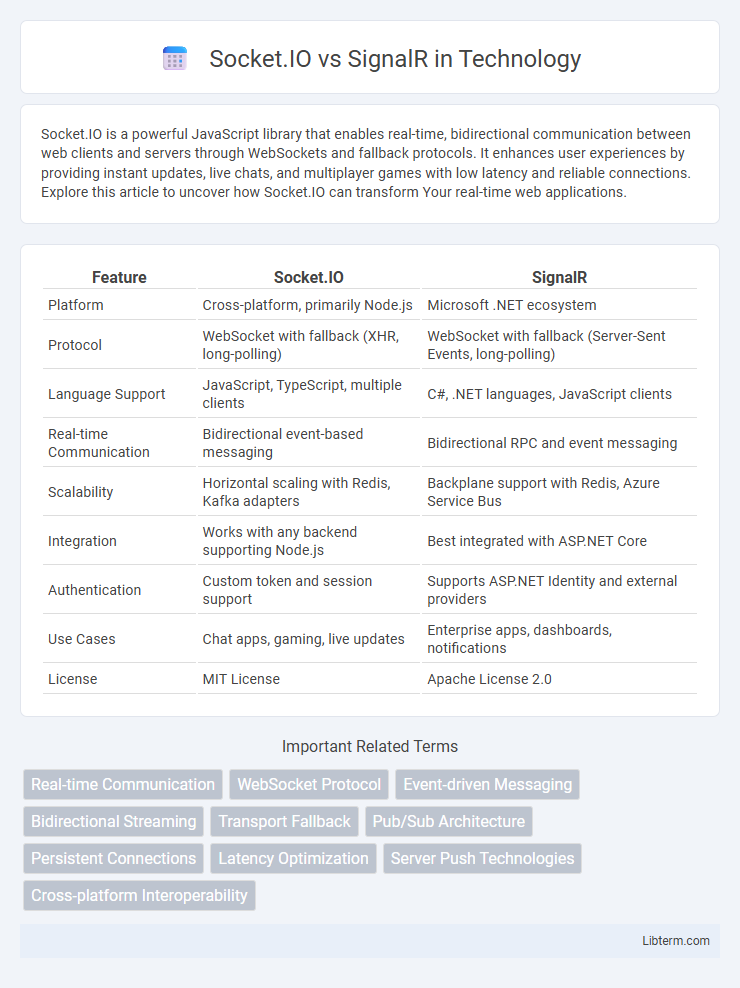Socket.IO is a powerful JavaScript library that enables real-time, bidirectional communication between web clients and servers through WebSockets and fallback protocols. It enhances user experiences by providing instant updates, live chats, and multiplayer games with low latency and reliable connections. Explore this article to uncover how Socket.IO can transform Your real-time web applications.
Table of Comparison
| Feature | Socket.IO | SignalR |
|---|---|---|
| Platform | Cross-platform, primarily Node.js | Microsoft .NET ecosystem |
| Protocol | WebSocket with fallback (XHR, long-polling) | WebSocket with fallback (Server-Sent Events, long-polling) |
| Language Support | JavaScript, TypeScript, multiple clients | C#, .NET languages, JavaScript clients |
| Real-time Communication | Bidirectional event-based messaging | Bidirectional RPC and event messaging |
| Scalability | Horizontal scaling with Redis, Kafka adapters | Backplane support with Redis, Azure Service Bus |
| Integration | Works with any backend supporting Node.js | Best integrated with ASP.NET Core |
| Authentication | Custom token and session support | Supports ASP.NET Identity and external providers |
| Use Cases | Chat apps, gaming, live updates | Enterprise apps, dashboards, notifications |
| License | MIT License | Apache License 2.0 |
Overview of Socket.IO and SignalR
Socket.IO is a JavaScript library enabling real-time, bidirectional communication between web clients and servers via WebSockets and fallback techniques. SignalR is a Microsoft framework designed for .NET applications, providing real-time web functionality with automatic connection management and support for multiple transport protocols. Both Socket.IO and SignalR facilitate live updates and instant messaging, but Socket.IO targets Node.js environments while SignalR integrates seamlessly with ASP.NET platforms.
Core Features Comparison
Socket.IO enables real-time bidirectional communication using WebSockets and falls back to other protocols for broader browser support, featuring automatic reconnection, multiplexing, and event-based messaging. SignalR, primarily for .NET applications, offers real-time web functionality with seamless integration into ASP.NET Core, supporting multiple transport protocols like WebSockets, Server-Sent Events, and Long Polling, along with built-in scaling via Azure SignalR Service. Both frameworks facilitate real-time updates but differ in language support and ecosystem integration, making Socket.IO well-suited for JavaScript environments and SignalR optimized for Microsoft-centric stacks.
Supported Platforms and Languages
Socket.IO primarily supports JavaScript and Node.js environments, enabling real-time bidirectional event-based communication for web browsers and servers. SignalR is designed for .NET applications, supporting C# across platforms like Windows, Linux, and macOS with integration in ASP.NET Core for real-time web functionality. Both frameworks offer client libraries for web, mobile, and desktop, but SignalR's deep integration with the Microsoft ecosystem contrasts with Socket.IO's broad support for web standards and non-.NET environments.
Real-Time Communication Protocols
Socket.IO and SignalR are powerful real-time communication protocols primarily used for web applications to enable bidirectional event-based communication. Socket.IO operates over WebSocket with automatic fallback to HTTP long polling, ensuring compatibility across different browsers and network conditions, and excels in low-latency communication for real-time updates in chat apps, gaming, and collaboration tools. SignalR, developed by Microsoft, integrates deeply with the ASP.NET ecosystem and supports multiple transport protocols including WebSockets, server-sent events, and long polling, optimized for scale and seamless integration in enterprise environments requiring robust real-time functionality.
Scalability and Performance
Socket.IO excels in real-time bidirectional communication with efficient event-driven architecture, supporting horizontal scaling through Redis or similar message brokers to manage multiple server instances. SignalR offers robust scalability using Azure SignalR Service and backplanes like Redis or SQL Server, ensuring seamless load distribution and connection management across large-scale applications. Performance benchmarks indicate Socket.IO provides lower latency in lightweight messaging scenarios, while SignalR optimizes throughput in enterprise environments with integrated Azure cloud services.
Integration with Existing Frameworks
Socket.IO offers seamless integration with Node.js and Express.js, making it highly suitable for applications already using these frameworks. SignalR is tightly integrated with Microsoft's ASP.NET Core, providing native support for .NET ecosystems and leveraging built-in features like dependency injection and middleware. Both libraries facilitate real-time communication but cater to different backend environments, so choosing between them depends largely on the current technology stack and framework compatibility.
Security Considerations
Socket.IO and SignalR both provide real-time communication frameworks with built-in security features like TLS encryption and authentication mechanisms. Socket.IO supports custom authentication and integrates well with OAuth protocols, while SignalR offers seamless integration with ASP.NET Core Identity and supports claims-based authentication for granular access control. Both platforms recommend implementing message validation, proper authorization checks, and using encrypted transport channels to safeguard against common vulnerabilities such as man-in-the-middle attacks and cross-site scripting.
Community Support and Documentation
Socket.IO benefits from a large, active open-source community with extensive GitHub contributions and numerous third-party tutorials, ensuring abundant resources for troubleshooting and learning. SignalR, maintained by Microsoft and integrated with the .NET ecosystem, offers comprehensive official documentation and strong enterprise support, which appeals to corporate developers seeking reliable guidance. Both technologies have vibrant forums and detailed API references, but Socket.IO's broader language support drives a wider community base compared to SignalR's Microsoft-centric audience.
Use Cases and Industry Adoption
Socket.IO excels in real-time applications such as chat apps, online gaming, and live collaboration tools, widely adopted in the JavaScript/Node.js ecosystem for its ease of integration and cross-platform support. SignalR is favored in enterprise environments, especially within the .NET framework, for applications like live dashboards, notifications, and interactive web portals due to its seamless integration with Microsoft technologies. Industry adoption of Socket.IO spans startups and tech companies focusing on web sockets, while SignalR is predominantly used by organizations leveraging Microsoft Azure and .NET infrastructure for scalable, real-time communication.
Choosing the Right Solution: Socket.IO or SignalR
Choosing between Socket.IO and SignalR depends on the application's ecosystem and language preference; Socket.IO excels with Node.js environments offering real-time bidirectional communication using WebSockets and fallback options. SignalR, integrated with the .NET framework, provides automatic connection management, scalability with Azure, and seamless support for server-to-client remote procedure calls. Evaluate the development stack, platform requirements, and performance needs to determine whether Socket.IO's JavaScript flexibility or SignalR's .NET features best suit your real-time communication project.
Socket.IO Infographic

 libterm.com
libterm.com